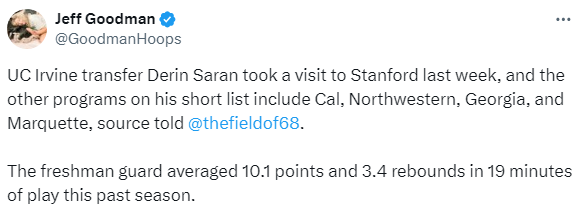Transfer Portal Update: Meet the New Bears Part 2
Hey, how about that, a whole new basketball team!
Last week we took a look at six new Bears who have joined through the transfer portal. And in just the past week, three more have jumped on board, so we’re giving them the same treatment.
Andrej Stojakovic, shooting guard, Stanford
In terms of recruiting rankings, Stojakovic is the most talented player Cal has added in the transfer portal. In terms of on-court production, he is nearly the least proven. And exactly how much Cal achieves on the court in the next couple years may well hinge on the extent to which Mark Madsen is able to unlock Stojakovic’s talent.
The biggest concern in his freshman numbers are his shooting splits. His recruiting pedigree was built in part on his reputation as a plus shooter, but that didn’t translate in year one, with a 47/33/53 split.
Of course, college basketball is littered with dudes who struggled as freshmen before breaking out as sophomores - for just a few examples you can look at the career arcs of three guys that are already a part of Cal’s portal class this year in DJ Campbell, Jeff Nwankwo, and Christian Tucker. It’s also a common pattern for talented Stanford recruits under Jerod Haase to struggle badly in year one - just look at KZ Okpala, Ziaire Williams, Harrison Ingram and Maxime Reynaud.
Most talent evaluators point to a need to add strength to his frame, but even without that Stojakovic should at minimum have the shooting talent to at least be a solid 3-and-D player. But he has the ability to be much more than that at the college level, and quite frankly I trust Mark Madsen and company much more than I do Jerod Haase to find and develop that talent.
Rytis Petraitis, forward, Air Force
Petraitis has a FASCINATING statistical profile. You see those red numbers in highlights? Petraitis ranks in the national top 500 in a LOT of categories, which indicates a guy with a ton of versatility. There aren’t many players with a 27% assist rate AND a 3.4% block rate. In short, he played like a high end point-forward at Air Force.
And he did that on a team where he got very little support. Air Force was OK his freshman year, but three key players either graduated or transferred, and Petraitis was kinda the only go-to creator left. He was the pivot in Air Force’s extreme slow down Princeton offense, dishing out assists, shooting from all over the floor, and drawing a ton of fouls. Based on what I’m seeing on the stat sheet, and playing on a team that didn’t really have a pass-first point guard, it looks like he kept the offense afloat with his versatility and gravity.
Air Force’s defense last year was a disaster scene, but it was fine in Petraitis’ freshman year so I’m pretty confident saying that he’s not a defensive liability.
And MOST importantly, he’s Lithuanian
Mady Sissoko, center, Michigan State
Let’s start with the obvious pluses here: we’re bringing in a guy who was a rotational player on a top 25 team for the past two years, with eye popping rebounding numbers. Sissoko’s floor is as a high end rebounder and rim protector who will score efficiently inside off of penetration dump offs and put backs.
His exact ceiling beyond that may depend on a cause-and-effect question: Did Tom Izzo limit Sissoko’s minutes because Michigan State had depth, and then instruct Sissoko to play really aggressive defense because he could afford to pick up a few fouls in limited court time? Or, did Sissoko struggle to avoid fouls, thus limiting his minutes?
It’s probably something of a combo - I’m wagering that Sissoko is foul prone, but that Michigan State was going to rotate their big men regardless. But with Lee Dort on the roster along with forwards who could probably play as small ball 5s for stretches, I doubt Cal will expect Sissoko (or Dort) to play 30+ minutes like they did Fardaws Aimaq last year.
Which means that Cal will almost certainly happily trade a few fouls in exchange for elite rebounding and efficient finishing inside.
One man’s way too early guess at a depth chart
Starters:
PG: Christian Tucker
G: DJ Campbell
Wing: Jeff Nwankwo
Forward: Rytis Petraitis
Center: Mady Sissoko
Rotational bench:
Guard Andrej Stojakovic
Center Lee Dort
Wing Josh Ola-Joseph
Forward BJ Omot
Depth/development:
Guard Jeremiah Wilkinson
Guard Vladimir Pavlovic
Center Devin Curtis
At least initially, I’d wager that we have three rotational players for two positions (Tucker, Campbell, and Stojakovic at PG/guard), four rotational players two positions (Nwankwo, Petraitis, Omot, and Ola-Joseph at wing/forward) and two rotational players for one position (Sissoko and Dort at center). Madsen often ran with a 8/9 player rotation at Utah Valley, and I’d project he’s likely to do the same next year with a much deeper roster than what he had in year 1 in Berkeley.
With the amount of proven talent Cal has brought in, my guess is that incoming freshman Jeremiah Wilkinson can play. limited spot minutes and have a year of development without being pushed into a rotational role. Maybe he’s so immediately talented that he forces his way in, which would be a very nice problem to have. But 3 star recruits aren’t usually immediate impact players at the power conference level.
How good is this team, in theory?
Well, last year Mark Madsen added four key rotation members to a team that finished 270th per Kenpom and 265th per Torvik, and immediately got them to 121st/119th.
Torvik has a projection system that gets updated all throughout the off-season as players come and go, and his projections put Cal at 70th in the nation. It’s worth noting that 70th doesn’t include the impact that Jeff Nwankwo might make as his system isn’t set up to consider JUCO transfers, nor obviously the impact of a potential 13th scholarship.
But to give you a baseline sense of what the ACC is projected to look like next year, here are the projections as of April 29th:
Not too bad! Also, lol Stanford.
What about the last scholarship slot?
12 of Cal’s 13 scholarship slots are now spoken for following Sissoko’s commitment on Monday.
In terms of portal players (read: not high school or JUCO prospects) that we know are on Cal’s radar, I’m aware of the following two players:
Derin Saran, UC Irvine
Mike Sharavjamts, USF
Saran and Sharavjamts have similar statistical profiles - both are combo guards with solid passing numbers. Sharavjamts has more size and played on the better team in the tougher league last year, but Saran is a year younger and was a touch more efficient, with better shooting numbers and fewer turnovers despite a higher usage percentage.
In terms of off-court intangibles, Saran is the son of a Cal soccer alum, which is very cool. But Sharavjamts was born in Mongolia, which is also very cool.
If this were my dream world and I could pick or choose, I’d take Saran for the extra year of eligibility and developmental possibilities, but either would be an excellent addition if they decide they want to come.
And just the fact that we’re discussing which combo guard might be our 10th rotational player just a few weeks after contemplating a roster with exactly 127 combined minutes of NCAA court time is incredible. I openly wished for a more stable roster, and while their are no guarantees in modern college basketball roster construction, Cal now has a more normal roster distribution with only two players projected to be out of eligibility following the end of next season.









Excellent analysis, thank you. There is an alchemy to this that you must see on the court. Kentucky got a lot of grief this year for having an uber talented team and underachieving relative to that talent. We all know that teams that play hard together will perform better than teams that don't. So I will be very curious to see how they are playing in November and December.
Kudos to Nick on another excellent write up…and Go Bears!!! Can’t wait to be in Haas for game 1. Who else will be there?